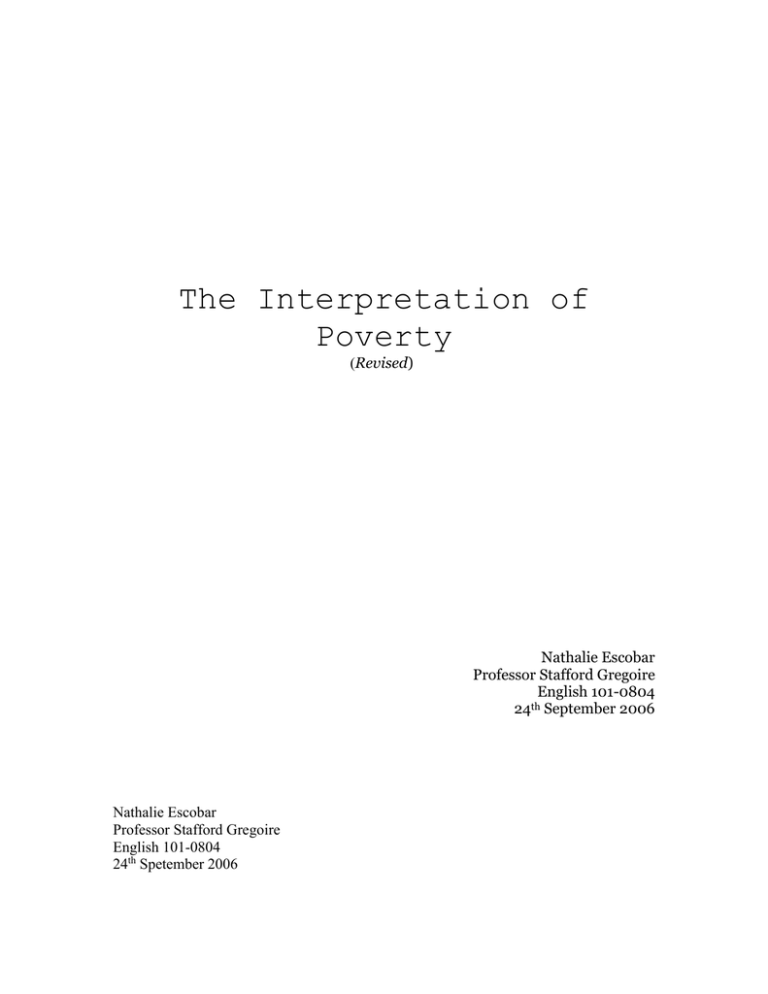The Interpretation of Poverty
advertisement

The Interpretation of Poverty (Revised) Nathalie Escobar Professor Stafford Gregoire English 101-0804 th 24 September 2006 Nathalie Escobar Professor Stafford Gregoire English 101-0804 24th Spetember 2006 Outline Title: The Interpretation of Poverty Introduction Different ways poverty can be shown Thesis → In “The Message”, Grandmaster Flash portrays the precise description of poverty by presenting the reader the living situation of residents in urban city areas. Body: I. The Cost of Survival - What people had to do in order to survive - “Crazy lady, livin’ in a bag; Eating out the garbage piles…” (Stanza 4 ,Sentences 1-2) - “She went to the city and got so so seditty / She had to get a pimp, she couldn’t make it on her own” (Stanza 4, Lines 7-8) II. Environment - Projects surroundings - The conditions of the projects are as similar outside - “Junkie’s in the alley way with a baseball bat” (Stanza 1, Sentence 7) - “They push that girl in front of the train” (Stanza 8, Sentence 4) III. Living Conditions - Bad living conditions in the projects - “Broken glass everywhere, People pissing on the stairs, you know they just don’t care, I can’t take the smell, I can’t take the noise … Rats in the front room, roaches in the back” (Stanza 1, Sentences 1-4 & Sentence 6) Conclusion: Reaffirm Thesis Nathalie Escobar Professor Stafford Grégoire English 101, Section 0804 24 September 2006 The Interpretation of Poverty In “The Message”, Grandmaster Flash displayed the projects of his current era through rap poetry. He wants people from the present that future times to have a sense of government housing. Grandmaster Flash wanted to show that people from the projects do have an intellect and that their “language of the streets” has equally valued knowledge. In order to describe his living to others, he gives an idea of his current depiction of underprivileged using slang, which others could interpret. In doing this, he demonstrate uses of imagery, metaphors and euphemism. In “The Message”, Grandmaster Flash portrays the precise slang description of poverty by presenting to the reader the living situations of residents in urban areas. Grandmaster Flash displays how people survive living around the urban areas. In “The Message”, “Crazy lady, livin’ in a bag / Eating out the garbage piles…”(Stanza 4, Lines 1-2) illustrates that the lady was literally living in a garbage bag and eating leftovers from the garbage to garbage to survive. “…used to be a fag-hag” (Stanza 4, Line 2) portrays that the woman has a sense of beauty, and would be comfortable around homosexual men than straight men. Grandmaster Flash used the slang term “fag-hag” to show what the woman used to be and whom she would prefer to be with but others would make fun of her. It can be a result of how she became insane and started living on the streets. “She went to the city and got so so seditty / She had to get a pimp, she couldn’t make it on her own” (Stanza 4, Lines 7-8) illustrates that the woman went to the city for her everyday living to become a prostitute. However, she could not survive by herself so she ended up getting a pimp to survive and get to places. To the peoples’ opinions, having to resort to prostitution, being homeless, etc, was a way of their cost of survival. The living situations in urban areas are so unsafe that people were not only afraid to step out, but also to leave their homes in the projects. From “The Message” is “Junkie’s in the alley way with a baseball bat” (Stanza 1, Line 7) defines that the Junkies would do anything to get drugs such as beating up innocent by standards. A metaphor statement “Me on king kong standin’ on my back” (Stanza 6, Line 9) is a term used for heroin addicts. Except, others used monkey on their backs, but the speaker of the poem used “king kong”. He used that term to stress out how huge the problem was and by representing, that it was difficult for him quit the use of heroin. The thoughts of the projects being dangerous were underestimated. Other distances such as the subways, were likewise as horrible. As for the subways conditions were, “They push that girl in front of the train” (Stanza 8, Line 4). “They” can be refer as to anyone, may be even people from the projects that pushed the girl. As an observation, “They” apparently think that pushing a girl would be a kind of entertainment and to others it shows their masculinity. Grandmaster Flash illustrated peoples how they would treat the government housing. With the use of imagery in the poem, it formed a realistic approach to the readers. The speaker of the poem describes the projects having “Broken glass everywhere, People pissing on the stairs, you know they just don’t care, I can’t take the smell, I can’t take the noise … Rats in the front room, roaches in the back” (Stanza 1, Lines 1-4 & Line 6). In the point of view of the speaker, he was displeased and annoyed living in the projects and its conditions. However, he has no other choice but to stay with no source of income. Grandmaster Flash illustrates “Broken glass everywhere” (Stanza 1, Line 1) as in that people breaking the glass either from gun shots, vandalism, etc. The people of the projects don’t bother fixing it because it would end up being broken again. “Rats in the front room, roaches in the back” (Stanza 1, Line 6) displays that the sanitation of the projects was horrible and that garbage of the projects wasn’t being properly taken care of. The speaker displays the residents’ of the building having no interests in fixing the condition because they feel that it is not they duty to tidy up. It is the decision and actions of the people that are willing to maintain positive living conditions. The reason is that the poverty cannot depend on the government to clean up after them. Eventually, urban areas from Grandmaster Flash’s era until now have drastically changed with appearance and diversity. The living situation of the projects in the urban areas improved with a vast decrease in violence, drugs, and prostitution. However, Grandmaster Flash eventually wanted others to acknowledge that people from the streets are also educated in their own way. The knowledge that the people studied came from their own concept of a University called the “University of the Streets.” The reputation of the projects might be appalling, but not the residents. People from the projects are not all awful. It is about free will and their choice of behavior. However, it falls on a stereotypical factor of various views and cultures from others.



